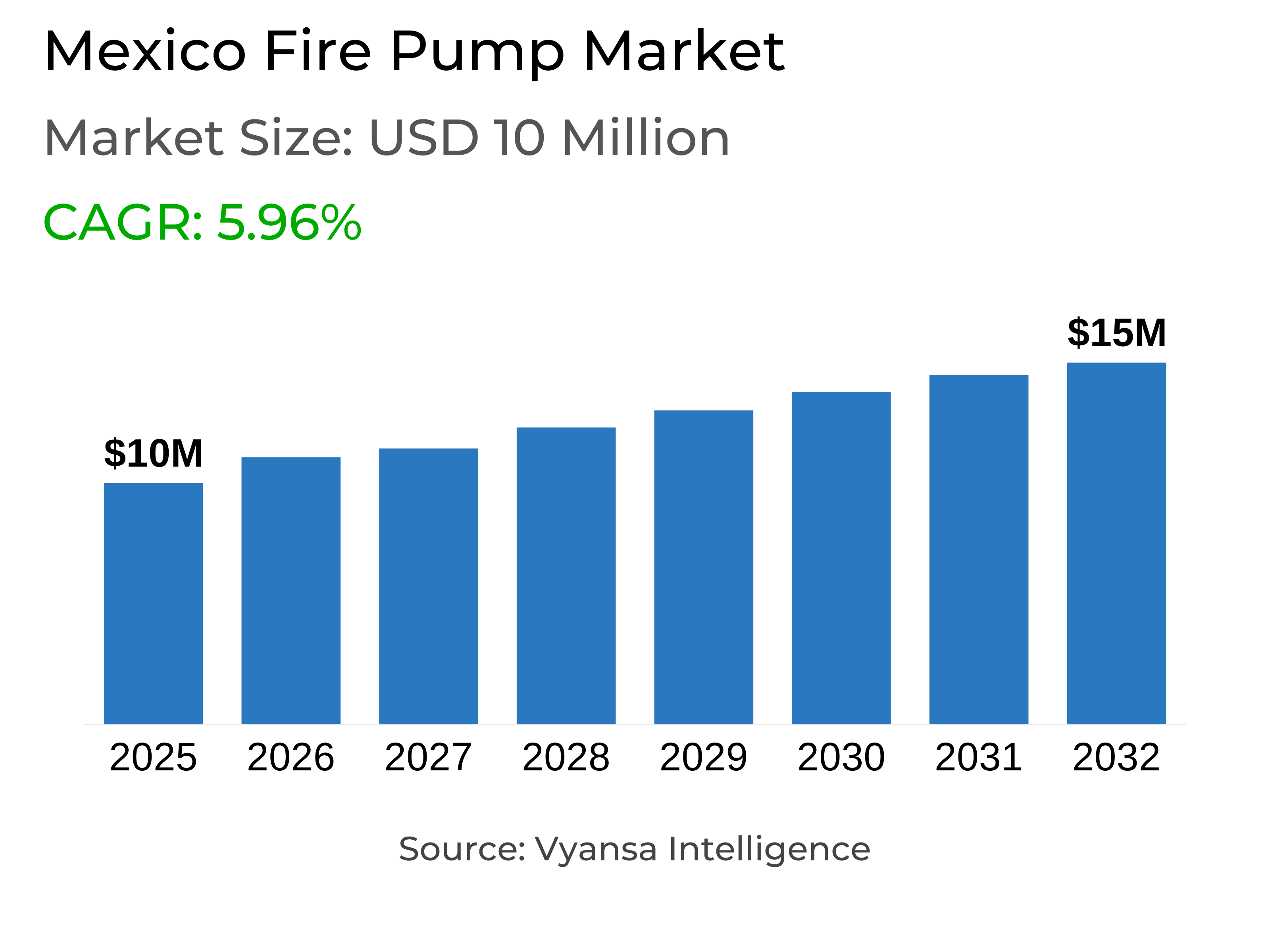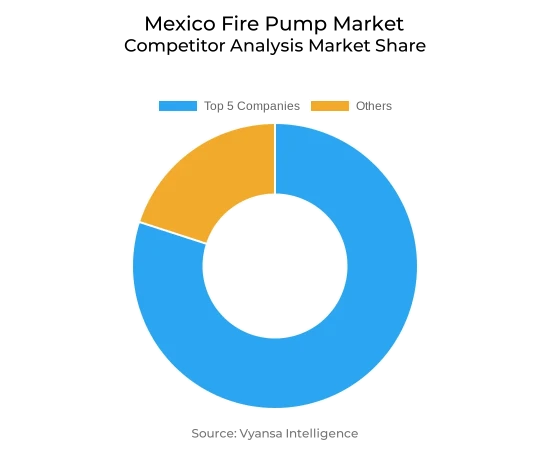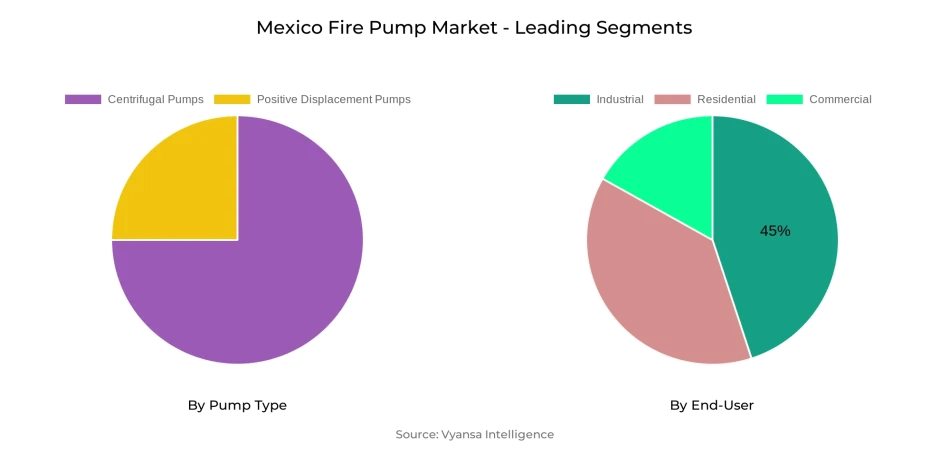
Mexico Fire Pump Market Report: Trends, Growth and Forecast (2026-2032)
By Pump Type (Centrifugal Pumps (Overhung Pumps, Vertical Inline, Horizontal End Suction), Split Case Pumps (Single/Two Stage, Multi Stage)), Positive Displacement Pumps (Diaphragm Pumps, Piston Pumps), By Mode of Operation (Diesel Fire Pump, Electric Fire Pump, Others), By End-User (Residential, Commercial, Industrial)
- Energy & Power
- Oct 2025
- VI0506
- 120
-




Mexico Fire Pump Market Statistics and Insights, 2026
- Market Size Statistics
- Fire Pump in Mexico is estimated at $ 10 Million.
- The market size is expected to grow to $ 15 Million by 2032.
- Market to register a CAGR of around 5.96% during 2026-32.
- Pump Type Segment
- Centrifugal Pumps continues to dominate the market.
- Competition
- More than 10 companies are actively engaged in producing Fire Pump in Mexico.
- Top 5 companies acquired the maximum share of the market.
- WILO SE, Ebara Corporation, ITT Goulds Pumps, Flowserve Corporation, Pentair PLC etc., are few of the top companies.
- End-User
- Industrial grabbed 45% of the market.
Mexico Fire Pump Market Outlook
The Mexico Fire Pump Market is expected to grow gradually from an estimated USD 10 million in 2025 to approximately USD 15 million by 2032, indicating a CAGR of 5.96% over 2026–32. Urban expansion and rigorous imposition of fire safety measures are fueling the expansion, with new builds in large cities requiring sophisticated firefighting equipment. This has elevated fire pumps to standard installations in commercial, residential, and public buildings, as well as driving facility managers to replace old equipment to ensure compliance and minimize the risk of operations.
Even with this momentum, the market still suffers from problems, especially in rural and semi-urban areas where unequal infrastructure investment restricts the installation of advanced fire pumps. Most municipalities have constrained budgets, leading to uneven coverage and compromised fire safety standards outside urban centers. Moreover, the lack of trained technicians who can service complex pump systems puts additional pressure, since delayed maintenance threatens performance and reliability.
On the technological side, the market is seeing robust moves towards smart monitoring and energy-efficient technologies. IoT-enabled equipment and wireless sensors now enable real-time monitoring of pump performance, avoiding expensive breakdowns through predictive maintenance. At the same time, variable-frequency drives (VFDs) are reducing energy consumption and operating expenses, supporting sustainability and tighter environmental regulations. All these are breaking the ground for next-generation firefighting infrastructure.
Centrifugal pumps take the lead from a segmentation point of view, with their performance, affordability, and maintenance capability, while positive displacement pumps cater to niche high-pressure applications. The industrial sector is the market leader among end users with a 45% share that is driven by sophisticated pumps to safeguard assets and adhere to regulation. While the residential sector is the next fastest-growing segment backed by increasing urban housing developments and enhanced safety consciousness.

Mexico Fire Pump Market Growth Driver
Expanding Urban Infrastructure and Safety Compliance
Sudden growth in urbanization coupled with strict regulatory compliance is stimulating high demand in the Mexico Fire Pump Market. Continuous development in major cities continuously demands the inclusion of advanced firefighting systems, so that fire pumps are installed as a mandatory component of commercial, residential, and public infrastructure. Regulatory push increases system dependability and forces investors to adhere to new safety protocols, stimulating market growth through extensive use of advanced pump technology on a large scale.
As the same time, greater vigilance concerning safety regulations on the part of facility managers is stimulating installation of older systems with newer, more efficient pumps. Upgrading legacy plants with state-of-the-art pumps not only complies with new regulatory standards but also reduces production stoppages and maintenance expenses. This combined focus on compliance and efficiency supports ongoing adoption, a steady foundation for growth on both new construction sites and in installed bases.
Mexico Fire Pump Market Challenge
Financial and Technical Barriers to Wider Deployment
Uneven infrastructure investment is still a strong restraint on the Mexico Fire Pump Market, especially in rural and semi-urban areas. Local governments in poorer regions tend to have fewer financial resources, which limits them from purchasing and fitting advanced firefighting equipment. Insufficient funding means uneven coverage throughout the nation and exposes rural communities to greater risks of fire. The disparity in deployment results in uneven overall fire safety infrastructure.
Compounding the problem is the lack of trained technicians who can service state-of-the-art fire pump systems. Specialized knowledge is needed for regular maintenance and repair, but the lack of certified professionals extends response times while increasing long-term service risks. Inaccessible pump designs then become problematic beyond urban centers, compromising system reliability and slowing widespread adoption. These limitations signal a significant restriction to level market penetration across the country.
Mexico Fire Pump Market Trend
Smart Technologies and Energy-Efficient Solutions
The Mexico Fire Pump Market is witnessing a significant change by virtue of incorporating smart monitoring systems. IoT platforms and wireless sensors now enable round-the-clock monitoring of pump performance, notifying operators of changes like drops in pressure or mechanical faults before they become full-blown failures. This proactive approach minimizes unplanned downtime, improves operational safety, and streamlines maintenance cycles for end users in industrial and residential applications.
Energy-efficient designs are also creating new performance standards. Variable-frequency drives (VFDs) facilitate pumps to vary output in response to demand, reducing energy consumption and operating costs. These technologies not only contribute to sustainability but also enhance adherence to tighter environmental regulations. Together, digital monitoring and energy efficiency are paving the way for next-generation firefighting infrastructure, driving reliability while responding to cost-control goals.
Mexico Fire Pump Market Opportunity
Expansion Through Partnerships and Service Models
Public–private partnerships (PPPs) are creating new opportunities for development in the Mexico Fire Pump Market. By combining government funds with private sector experience, these public–private collaborations bring the capital and technical expertise required to expand firefighting infrastructure in underserved areas. These efforts represent a sound way to increase safety coverage across the country while speeding the replacement of old municipal systems.
Moreover, aftermarket service contracts are becoming a lucrative business model for manufacturers and service providers alike. Maintenance packages that encompass regular checks and remote diagnostics provide end users with a predictable cost structure and reassurance. For the providers, these long-term contracts yield steady income while strengthening brand loyalty. Combined, PPP-led projects and service-based income streams reflect lucrative prospects for both infrastructure development and sustainable business expansion.
Mexico Fire Pump Market Segmentation Analysis

By Pump Type
- Centrifugal Pumps
- Positive Displacement Pumps
Centrifugal Pumps have the largest market share in the Mexico Fire Pump Market, and they continue to lead the way owing to their cost-effectiveness, flexibility, and minimal maintenance needs. Their simplicity of design and capability to deal with varied conditions of flow make them extremely well-suited for commercial building as well as industrial processes, where fire safety codes must be followed. The above factors make centrifugal pumps the first preference in new developments as well as retrofits.
On the other hand, Positive Displacement Pumps still maintain a more specialized niche, especially where incredibly high pressures are required. Though their percentage of total installations is still smaller, they have an important role to play in establishments that call for specialized performance. Nevertheless, the extensive applications of centrifugal models emphasize their unbeatable integration benefits, solidifying their position as market leader in pump type segmentation.
By End-User
- Residential
- Commercial
- Industrial
The Industrial segment holds the greatest market share of the Mexico Fire Pump Market with a demand of 45%. Advanced fire pumps are depended on by industrial facilities to protect valuable assets, ensure continuity in operations, and achieve stringent regulatory compliance. Such sites require powerful, reliable systems due to complexity and size, making the industrial segment the driving force of the market.
In contrast, the Residential segment is becoming the most rapidly growing end-user segment with a CAGR of 3.79%. Urban residential schemes increasingly involve integrated fire protection systems based on regulatory mandates and increasing sensitivity among residents and developers. The upsurge in residential demand supplements the established leadership of the industrial segment, diversifying market trends and broadening the overall application base for fire pumps in Mexico.
Top Companies in Mexico Fire Pump Market
The top companies operating in the market include WILO SE, Ebara Corporation, ITT Goulds Pumps, Flowserve Corporation, Pentair PLC, Sulzer Limited, Grundfos Holding A/S, KSB SE & Co. KGaA, Patterson (Gorman Rupp), Armstrong, etc., are the top players operating in the Mexico Fire Pump Market.
Frequently Asked Questions
Related Report
1. Market Segmentation
1.1. Research Scope
1.2. Research Methodology
1.3. Definitions and Assumptions
2. Executive Summary
3. Mexico Fire Pump Market Policies, Regulations, and Standards
4. Mexico Fire Pump Market Dynamics
4.1. Growth Factors
4.2. Challenges
4.3. Trends
4.4. Opportunities
5. Mexico Fire Pump Market Statistics, 2022-2032F
5.1. Market Size & Growth Outlook
5.1.1.By Revenues in US$ Million
5.2. Market Segmentation & Growth Outlook
5.2.1.By Pump Type
5.2.1.1. Centrifugal Pumps- Market Insights and Forecast 2022-2032, USD Million
5.2.1.1.1.1. Overhung Pumps- Market Insights and Forecast 2022-2032, USD Million
5.2.1.1.1.2. Vertical Inline- Market Insights and Forecast 2022-2032, USD Million
5.2.1.1.1.3. Horizontal End Suction- Market Insights and Forecast 2022-2032, USD Million
5.2.1.1.2. Split Case Pumps- Market Insights and Forecast 2022-2032, USD Million
5.2.1.1.2.1. Single/Two Stage- Market Insights and Forecast 2022-2032, USD Million
5.2.1.1.2.2. Multi Stage- Market Insights and Forecast 2022-2032, USD Million
5.2.1.2. Positive Displacement Pumps- Market Insights and Forecast 2022-2032, USD Million
5.2.1.2.1. Diaphragm Pumps- Market Insights and Forecast 2022-2032, USD Million
5.2.1.2.2. Piston Pumps - Market Insights and Forecast 2022-2032, USD Million
5.2.2.By Mode of Operation
5.2.2.1. Diesel Fire Pump- Market Insights and Forecast 2022-2032, USD Million
5.2.2.2. Electric Fire Pump- Market Insights and Forecast 2022-2032, USD Million
5.2.2.3. Others- Market Insights and Forecast 2022-2032, USD Million
5.2.3.By End-User
5.2.3.1. Residential- Market Insights and Forecast 2022-2032, USD Million
5.2.3.2. Commercial- Market Insights and Forecast 2022-2032, USD Million
5.2.3.3. Industrial- Market Insights and Forecast 2022-2032, USD Million
5.2.4.By Competitors
5.2.4.1. Competition Characteristics
5.2.4.2. Market Share & Analysis
6. Mexico Centrifugal Fire Pump Market Statistics, 2020-2030F
6.1. Market Size & Growth Outlook
6.1.1.By Revenues in US$ Million
6.2. Market Segmentation & Growth Outlook
6.2.1.By Pump Type- Market Insights and Forecast 2022-2032, USD Million
6.2.2.By Mode of Operation- Market Insights and Forecast 2022-2032, USD Million
6.2.3.By End-User- Market Insights and Forecast 2022-2032, USD Million
7. Mexico Positive Displacement Fire Pump Market Statistics, 2020-2030F
7.1. Market Size & Growth Outlook
7.1.1.By Revenues in US$ Million
7.2. Market Segmentation & Growth Outlook
7.2.1.By Pump Type- Market Insights and Forecast 2022-2032, USD Million
7.2.2.By Mode of Operation- Market Insights and Forecast 2022-2032, USD Million
7.2.3.By End-User- Market Insights and Forecast 2022-2032, USD Million
8. Competitive Outlook
8.1. Company Profiles
8.1.1.Flowserve Corporation
8.1.1.1. Business Description
8.1.1.2. Product Portfolio
8.1.1.3. Collaborations & Alliances
8.1.1.4. Recent Developments
8.1.1.5. Financial Details
8.1.1.6. Others
8.1.2.Pentair PLC
8.1.2.1. Business Description
8.1.2.2. Product Portfolio
8.1.2.3. Collaborations & Alliances
8.1.2.4. Recent Developments
8.1.2.5. Financial Details
8.1.2.6. Others
8.1.3.Sulzer Limited
8.1.3.1. Business Description
8.1.3.2. Product Portfolio
8.1.3.3. Collaborations & Alliances
8.1.3.4. Recent Developments
8.1.3.5. Financial Details
8.1.3.6. Others
8.1.4.Grundfos Holding A/S
8.1.4.1. Business Description
8.1.4.2. Product Portfolio
8.1.4.3. Collaborations & Alliances
8.1.4.4. Recent Developments
8.1.4.5. Financial Details
8.1.4.6. Others
8.1.5.KSB SE & Co. KGaA
8.1.5.1. Business Description
8.1.5.2. Product Portfolio
8.1.5.3. Collaborations & Alliances
8.1.5.4. Recent Developments
8.1.5.5. Financial Details
8.1.5.6. Others
8.1.6.WILO SE
8.1.6.1. Business Description
8.1.6.2. Product Portfolio
8.1.6.3. Collaborations & Alliances
8.1.6.4. Recent Developments
8.1.6.5. Financial Details
8.1.6.6. Others
8.1.7.Ebara Corporation
8.1.7.1. Business Description
8.1.7.2. Product Portfolio
8.1.7.3. Collaborations & Alliances
8.1.7.4. Recent Developments
8.1.7.5. Financial Details
8.1.7.6. Others
8.1.8.ITT Goulds Pumps
8.1.8.1. Business Description
8.1.8.2. Product Portfolio
8.1.8.3. Collaborations & Alliances
8.1.8.4. Recent Developments
8.1.8.5. Financial Details
8.1.8.6. Others
8.1.9.Patterson (Gorman Rupp)
8.1.9.1. Business Description
8.1.9.2. Product Portfolio
8.1.9.3. Collaborations & Alliances
8.1.9.4. Recent Developments
8.1.9.5. Financial Details
8.1.9.6. Others
8.1.10. Armstrong
8.1.10.1. Business Description
8.1.10.2. Product Portfolio
8.1.10.3. Collaborations & Alliances
8.1.10.4. Recent Developments
8.1.10.5. Financial Details
8.1.10.6. Others
9. Disclaimer
| Segment | Sub-Segment |
|---|---|
| By Pump Type |
|
| By Mode of Operation |
|
| By End-User |
|
Research Methodology
This study followed a structured approach comprising four key phases to assess the size and scope of the electro-oxidation market. The process began with thorough secondary research to collect data on the target market, related markets, and broader industry context. These findings, along with preliminary assumptions and estimates, were then validated through extensive primary research involving industry experts from across the value chain. To calculate the overall market size, both top-down and bottom-up methodologies were employed. Finally, market segmentation and data triangulation techniques were applied to refine and validate segment-level estimations.
Secondary Research
The secondary research phase involved gathering data from a wide range of credible and published sources. This step helped in identifying industry trends, defining market segmentation, and understanding the market landscape and value chain.
Sources consulted during this phase included:
- Company annual reports, investor presentations, and press releases
- Industry white papers and certified publications
- Trade directories and market-recognized databases
- Articles from authoritative authors and reputable journals
- Gold and silver standard websites
Secondary research was critical in mapping out the industry's value chain and monetary flow, identifying key market segments, understanding regional variations, and tracking significant industry developments.
Other key sources:
- Financial disclosures
- Industry associations and trade bodies
- News outlets and business magazines
- Academic journals and research studies
- Paid industry databases
Primary Research
To validate secondary data and gain deeper market insights, primary research was conducted with key stakeholders across both the supply and demand sides of the market.
On the demand side, participants included decision-makers and influencers from end-user industries—such as CIOs, CTOs, and CSOs—who provided first-hand perspectives on market needs, product usage, and future expectations.
On the supply side, interviews were conducted with manufacturers, industry associations, and institutional participants to gather insights into current offerings, product pipelines, and market challenges.
Primary interviews provided critical inputs such as:
- Market size and revenue data
- Product and service breakdowns
- Market forecasts
- Regional and application-specific trends
Stakeholders consulted included:
- Leading OEM and solution providers
- Channel and distribution partners
- End users across various applications
- Independent consultants and industry specialists
Market Size Estimation and Data Triangulation
- Identifying Key Market Participants (Secondary Research)
- Goal: To identify the major players or companies in the target market. This typically involves using publicly available data sources such as industry reports, market research publications, and financial statements of companies.
- Tools: Reports from firms like Gartner, Forrester, Euromonitor, Statista, IBISWorld, and others. Public financial statements, news articles, and press releases from top market players.
- Extracting Earnings of Key Market Participants
- Goal: To estimate the earnings generated from the product or service being analyzed. This step helps in understanding the revenue potential of each market player in a specific geography.
- Methods: Earnings data can be gathered from:
- Publicly available financial reports (for listed companies).
- Interviews and primary data sources from professionals, such as Directors, VPs, SVPs, etc. This is especially useful for understanding more nuanced, internal data that isn't publicly disclosed.
- Annual reports and investor presentations of key players.
- Data Collation and Development of a Relevant Data Model
- Goal: To collate inputs from both primary and secondary sources into a structured, data-driven model for market estimation. This model will incorporate key market KPIs and any independent variables relevant to the market.
- Key KPIs: These could include:
- Market size, growth rate, and demand drivers.
- Industry-specific metrics like market share, average revenue per customer (ARPC), or average deal size.
- External variables, such as economic growth rates, inflation rates, or commodity prices, that could affect the market.
- Data Modeling: Based on this data, the market forecasts are developed for the next 5 years. A combination of trend analysis, scenario modeling, and statistical regression might be used to generate projections.
- Scenario Analysis
- Goal: To test different assumptions and validate how sensitive the market is to changes in key variables (e.g., market demand, regulatory changes, technological disruptions).
- Types of Scenarios:
- Base Case: Based on current assumptions and historical data.
- Best-Case Scenario: Assuming favorable market conditions, regulatory environments, and technological advancements.
- Worst-Case Scenario: Accounting for adverse factors, such as economic downturns, stricter regulations, or unexpected disruptions.
Partnering With Industry Leaders to Drive Growth
Our mission is to deliver intelligence that matters. By combining data, analysis, and industry expertise, we enable organizations to make smarter, faster, and more impactful decisions. Whether it’s a Fortune 500 company or a high-growth startup, businesses trust us to provide clarity in an ever-evolving marketplace.






